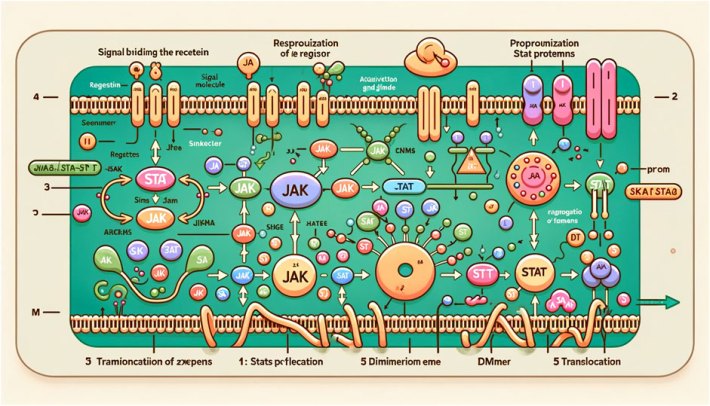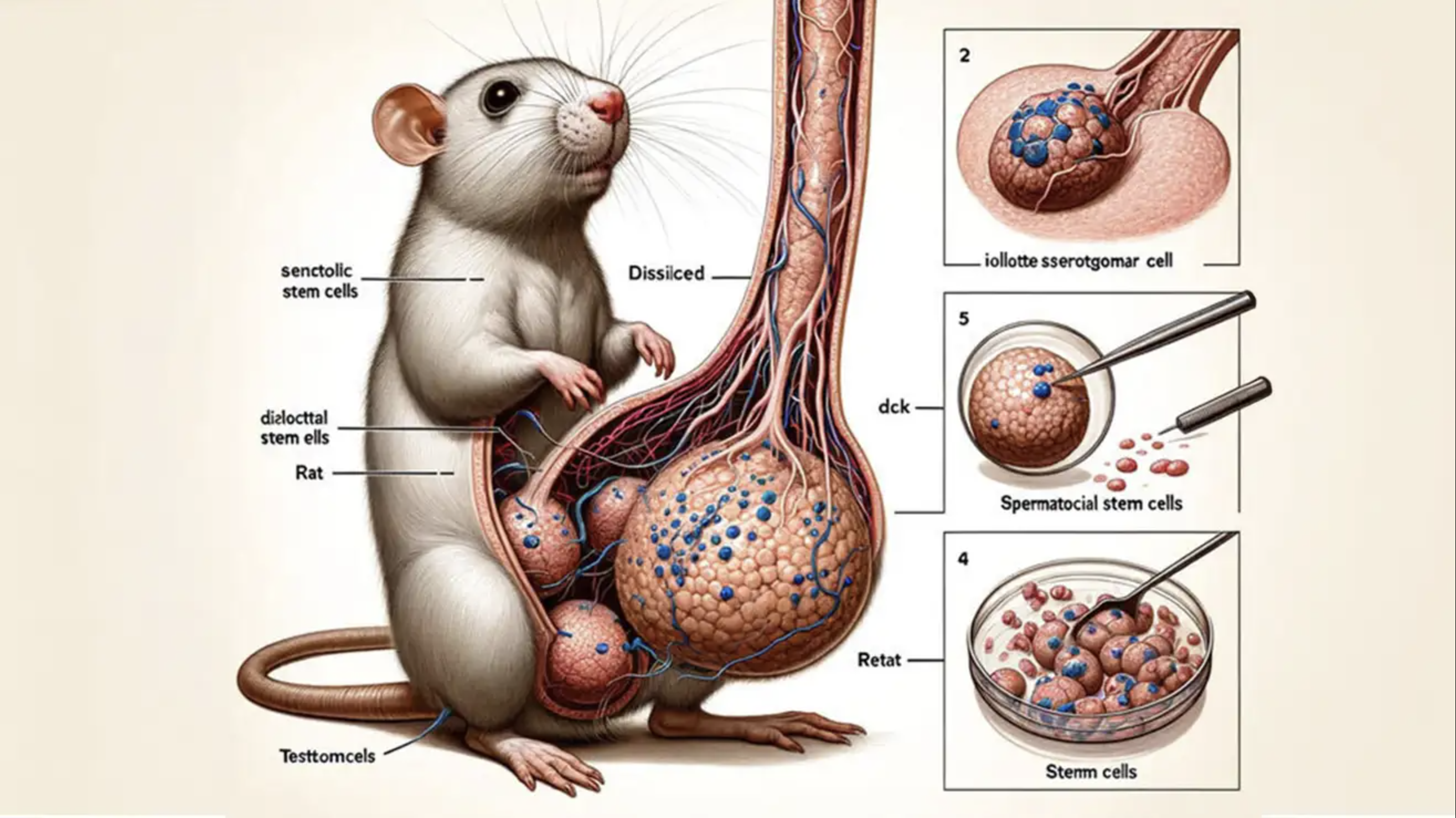Last week, an indelible image of rodent genitalia was published in the serious-sounding journal Frontiers in Cell and Developmental Biology, in an equally serious-sounding paper titled "Cellular functions of spermatogonial stem cells in relation to JAK/STAT signaling pathway." Yet the image was deeply unserious, depicting a white rat sitting on his hind legs and gazing upward at an unspeakably large, bisected penis that appears to be accompanied by not two but four balls of varying sizes. Even the rat looks confused by this gargantuan size of his shaft, as if, like Gregor Samsa, he had awoken one day to find his regular-sized dongle had transformed into an old-growth redwood towering into some unseen sky. He does not appear disturbed by the abject terror that is his overstuffed ball sack, presumably because he is preoccupied with his penis.
The scientific community was horrified by this rat's penis—not for being a rat's penis, for there is no shame in that, but rather due to the fact that an image this ridiculously inaccurate could be published in a prominent scientific journal. The world is blessed with an abundance of genital diversity, but there is no known rat whose entire body is dwarfed by his penis and testicles. The paper's three authors, who work at Hong Hui Hospital and Jiaotong University in China, credited the AI-art generator Midjourney as the creator of the image. And a closer look at the labels hovering around the rat, its junk, and the cells presumably extracted from its junk, revealed the text was about as decipherable as Simlish. The rat was labelled "Rat," but this Rat had "Testtomcels" and its member appeared "Dissilced." The inset to the side of the rat included the labels "iollotte sserotgomar cell," Stemm cells," "Retat," and, brief and poetic as an erasure poem, "dck."
The resounding uproar over this Retat and his dck, which included several cookie recreations, led Frontiers to retract the paper by the end of the week, on the grounds that the article "does not meet the standards of editorial and scientific rigor for Frontiers in Cell and Development Biology." If you would like to read it in full, the scientific integrity consultant Elisabeth Bik uploaded a PDF of the original paper to her blog.

Although Retat dck stole the headlines, every image in the paper falls apart under even a casual glance. Figure 2 claims to be a "Diagram of the JAK-STAT signaling pathway" includes the similarly inscrutable labels "5 dimimeriom eme" and "Proprunization State protemns" and "Sinkecter," which I can only assume is a worker-owned site where sickos blog about sinks. Figure 3 appears to comprise a collage of haunted pizzas. "The paper is actually a sad example of how scientific journals, editors, and peer reviewers can be naive – or possibly even in the loop – in terms of accepting and publishing AI-generated crap," Bik wrote on her blog.
Frontiers is a peer-reviewed scientific journal, begging the question, what did these peers think of Retat dck? One of the paper's reviewers, Jingbo Dai of Northwestern University, told Vice that the responsibility of publishing such images lies with the publisher. According to the journal's policy, Frontiers allows "acceptable uses of generative AI technologies" in the papers it publishes, provided the AI generator is credited and the content is free from plagiarism. The policy states the human authors are responsible for vetting the factual accuracy of this content, raising the question—can any AI-generated image be factually accurate? What changes would need to happen to this rat and his enormous cock and balls such that he would pass as factual? If "Testtomcels" were corrected to testicles and the rat had just two of them, would that be enough? If the rat's penis were given an accurate scale bar, would that be more accurate? If the rat were screaming in terror at the horrors frothing from his nether regions, would that be more believable?
The Retat has sounded a wake-up call about the scourge of AI-generated imagery that has begun slipping into academic publishing. But not all shitty AI images will be as flamboyantly fraudulent as this engorged dck. As Bik points out on her blog, "These figures are clearly not scientifically correct, but if such botched illustrations can pass peer review so easily, more realistic-looking AI-generated figures have likely already infiltrated the scientific literature." This is the larger concern: that academic papers that have putatively passed peer review are already riddled with AI-derived swill. It's an open secret that at certain journals, peer review doesn't mean much.
The larger scourge is the threat of so-called predatory or questionable journals, which run on an exploitative pay-to-play model, in which authors pay fees to submit papers that, despite labels, are not actually peer-reviewed or edited in any substantial way. Predatory journals aggressively solicit manuscripts from researchers, who are often eager to publish as their number of publications can determine whether they graduate or advance in their careers. Predatory journals "sow confusion, promote shoddy scholarship, and waste resources," according to a comment published in Nature in 2019. Many researchers consider the MDPI and Frontiers family of journals to be predatory, and editors have left these journals because they found it impossible to reject junk articles. But it can be difficult to distinguish predatory journals from legitimate ones; Frontiers was ranked as the third-most cited publisher in 2022. The authors who published Retat dck would have paid $3,295 to publish their now-retracted paper.
It would honestly be great if the worst thing that emerged from a lack of peer review were an increasingly obscene series of AI-generated animal dicks. But this pseudoscience poses material harm to science itself and the people who are affected by it. Consider the time in 2015 when Frontiers in Public Health published a paper questioning the link between HIV and AIDS, eventually relabeling the paper as "opinion" after righteous public outcry, and ultimately retracting the paper in 2018. Consider the papers that remain unretracted, such as this anti-trans paper from 2021 that was reviewed by an anti-trans researcher who used to be a conversion therapist and edited by a researcher who is openly a gender critic. Although Retat dck blazed through the internet in a single week and left a phallic imprint that will not be soon forgotten, retracting one paper does nothing to change the larger forces that have created the current state of scientific publishing.
As a science writer, I have noticed a significant uptick of AI images starring in press releases for new papers: DALL-E's generic swirling cosmos on a press release for a preprint on supernovae or DALL-E's rendering of a "soft summer evening in the Paleoproterozoic" promoting a paper on microfossils. In an inevitable irony, one article summarizing the saga of Retat dck used its own, entirely different and disturbing AI-generated image of a rat as a leading photo. These images are not inside the papers themselves, embedded in history, yet they still guide how people visualize and understand the science, and their continued proliferation means fewer paid opportunities for scientific illustrators whose human perspective can bring a kind of imaginative poetry to the stodgiest scientific text. Because the only honest answer to the question "Why he look like that?" as applied to the above Retat would be something like: Resprouization of e regisor proprounization stat protemns, tramioncatiion of zœpens: stats poflecation dimimeriom eme regsttes sinkecter, dck!






